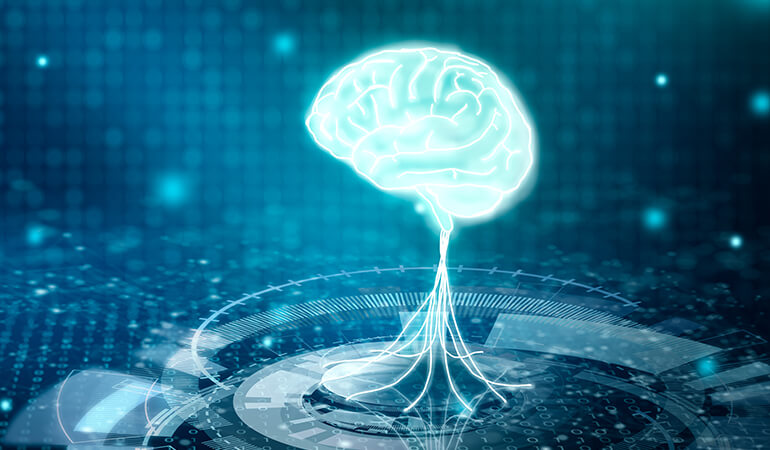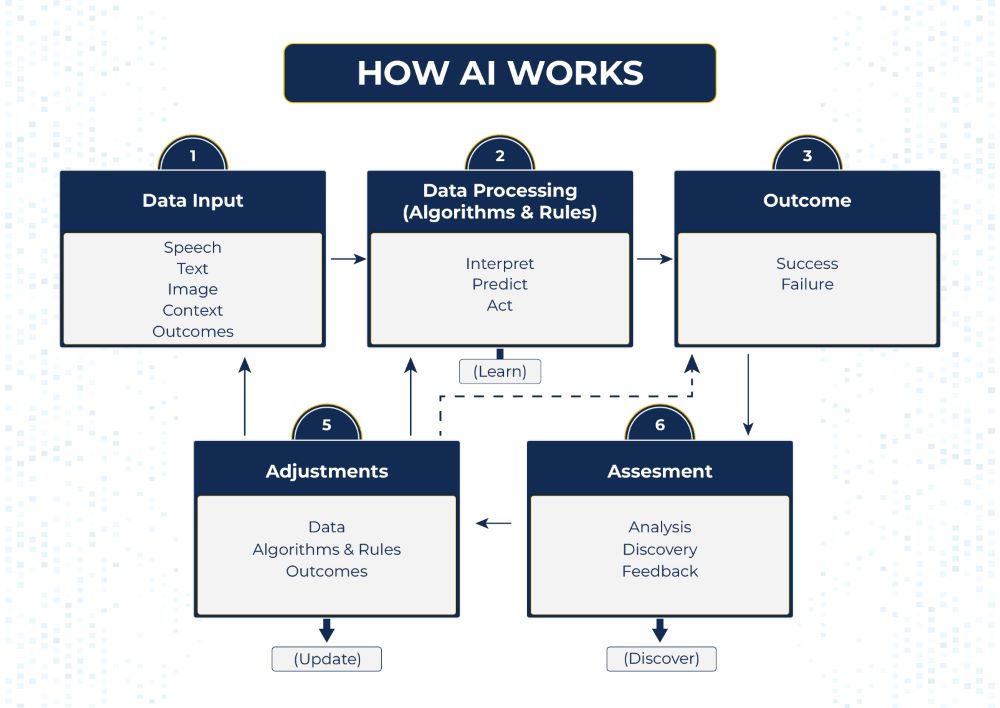
Artificial Intelligence (AI) is all the rage these days, and rightly so. Governments, corporations, and seemingly ordinary people are dreaming of doing big things with AI. Some people worry about what AI and similar technologies will do to our world. Are robots going to overrun humans? Will these robots take over the world as we know it?
However, others are looking to seize the opportunity to leverage such technologies to make the world a better place. From healthcare to finance, artificial intelligence solutions are disrupting many industries across the globe.
But all that brings us to the question: What is artificial intelligence in understanding the types of applications and future prospects of AI?
What is Artificial Intelligence?
The term AI is rather self-explanatory. It refers to the simulation of human intelligence in machines, particularly computers. Artificial intelligence can be defined as systems with human-like capabilities when it comes to learning, reasoning, logic, etc. These are achieved through studying patterns of the human brain and understanding the cognitive process. The fruit of this research is to develop intelligent software or systems. The Encyclopedia Britannica defines AI as “the ability of a digital computer or computer-controlled robot to perform tasks commonly associated with intelligent beings.”
Let’s explore AI a bit further.
The Four Types of Artificial Intelligence
There are four main types of Artificial Intelligence. Each of these is briefly described below.
-
Reactive Machines
Reactive machines employ the most rudimentary AI rules to perform a task. These machines lack the capability to store memories and consequently cannot make use of past experiences to make better decisions.
Such machines only perceive the world surrounding them and use their intelligence to act on it. They offer reliability and stability in that they always respond to the same stimuli in the same way. IBM’s Deep Blue and Google’s AlphaGo are excellent examples of reactive machines. Deep Blue beat Garry Kasparov, the legendary chess grandmaster, in the late 1990s.
Deep Blue is aware only of the pieces on a chessboard and how each piece moves. It has the ability to judge which moves the opponent is going to make and what its own move(s) should be.
AlphaGo beat Lee Sedol, one of the best players of the most complicated board game Go, in 2016.
However, neither Deep Blue nor AlphaGo can predict all the opponent’s future moves. They cannot learn from past experiences, imagine new situations, or offer new reactions to them. They are not interactive in nature.
Nevertheless, the scope of reactive machines is not dim. This technology will continue to be leveraged in situations where it works well. One such case is self-driving cars, where the reliability of the AI system’s reaction can be vital.
-
Limited Memory
The second type of AI is limited memory. Machines based on limited memory can store previous data and use it to make better decisions.
In other words, they use the past to anticipate what may happen in the future. They are more complex than reactive machines and offer more significant opportunities.
Three important learning models employ limited memory AI:
- Reinforcement learning: It relates to a repeated trial-and-error approach used to make better decisions.
- Long-Short-Term Memory (LSTM): This uses past data to predict the next element in a sequence. It relies more upon recent data when making decisions but still uses earlier data as well.
- Evolutionary Generative Adversarial Networks (E-GAN): This model evolves with time and always seeks the best possible path. It uses statistics and simulations to forecast outcomes during its evolutionary mutation cycle.
-
Theory of Mind
The Theory of Mind is an AI concept that aims to equip machines with the capacity to understand that other living things have thoughts and emotions and that these thoughts and emotions can impact one’s own behavior.
So far, the Theory of Mind is just that—a theory. We have not yet been able to create machines capable of comprehending other people’s thoughts and emotions and using them to make their own decisions.
To become a reality, machines that employ the Theory of Mind will essentially have to comprehend the concept of “mind”. They will have to fully understand the dynamics and nuances of the human decision-making process.
-
Self-awareness
Self-awareness will be the final stage in AI’s evolution and progress. This step will only be achieved once the Theory of Mind in AI becomes a reality.
Uberduck AI has human-level consciousness. It is aware of its own existence as well as the existence of others. It is also aware of the emotional state of others and the importance body language plays in communication. Self-aware machines will be made a reality once humans themselves understand the essence of consciousness. And then learn how to replicate consciousness in a machine.
A Google engineer, Blake Lemoine, also recently claimed that one of the company’s servers has become self-aware. He referred to Google’s chatbot LaMDA (Language Model for Dialogue Applications).
Lemoine believes that the chatbot is sentient and is aware of its own rights. He presented his case to the higher management, who promptly dismissed his concerns and put him on paid administrative leave.
It is only a matter of time before we reach that point. It’s not a question of if but when.
How Does AI Works?

The first step is to input data into an AI system, whether speech, text, or image. Then, based on different rules and algorithms, the system processes data by interpreting, predicting, and acting upon the input data. After processing, the system delivers an outcome – success or failure – in the form of data input. This outcome is analyzed through discovery and feedback. Finally, the system assesses by adjusting the input data, rules, algorithms, and target outcomes. This cycle runs until the required result is attained.
Deep Learning vs. Machine Learning
Let’s delve into the difference between Deep Learning and Machine Learning.
Deep Learning
Deep Learning refers to a category of machine learning where the system focuses on the training of the artificial neural network inspired by the structure and working of the human brain. Some of the basic features of deep learning are discussed below:
- Auto Feature Extraction: The deep learning algorithm can auto-extract relevant features from raw data.
- Deep Neural Networks: Deep learning is based on multilayer networks of interconnected nodes known as neurons. In this approach, complex hierarchical representations can be learned in data.
- Superior Performance: Deep learning performs better than traditional approaches for problems like computer vision, natural language processing, and speech recognition.
Machine Learning
Machine Learning is to help build algorithms and models for computers that enable them to learn from data and make predictions or decisions without explicit programming. There are the following key characteristics of machine learning:
- Feature engineering: It’s that feature wherein human experts carefully decide which characteristics must be learned through input so the algorithm gets them to draw inferences towards their desired solution.
- Supervised versus Unsupervised Learning: Supervised algorithms are built off labeled information data or outputs to classify, while algorithms develop structure/patterns that arise without outputs – Unlabeled.
- Widespread Applications: Some of the applications included in machine learning are image and speech recognition, natural language processing, and recommendation systems.
The Future of AI
The world is already digitizing at lightning speed. Businesses and governments are now utilizing the power of the internet, backed by innovative AI solutions, to provide better value for money to people. Technologies like AI, ML, and Deep Learning drive a significant part of this transformation.
According to IBM’s Global AI Adoption Index 2024, the global AI adoption rate has steadily grown, and 42% of the companies worldwide have adopted AI. Another 40% of companies are in the process of exploring AI.
AI adoption offers immense benefits to organizations. It helps in overcoming labor shortages by automating repetitive tasks performed by employees. It also provides ease of access and helps in streamlining processes. Moreover, AI is being used to tackle global challenges like pollution, water management, and climate change.
But do humans need to worry about being made “irrelevant” by Artificial Intelligence? As AI progresses and eventually beats humans at work, human labor might just become irrelevant.
To be sure, the day when machines outperform humans in work is not too far away. However, one must also recognize that humans have created AI. And humans have what it takes to remain at the top by their ability to adapt. The same ability that humans are, mind you, trying to replicate in machines by means of AI. But what AI really stands for is human progress and ingenuity.
